University Nursing Essay: Professional Communication and Patient Care
VerifiedAdded on 2022/09/26
|6
|1642
|29
Essay
AI Summary
This essay examines the critical role of effective communication in nursing practice, emphasizing its impact on therapeutic nurse-patient relationships and patient safety. The essay uses a case study of Mr. George, a 74-year-old patient, to illustrate the application of verbal and non-verbal communica...
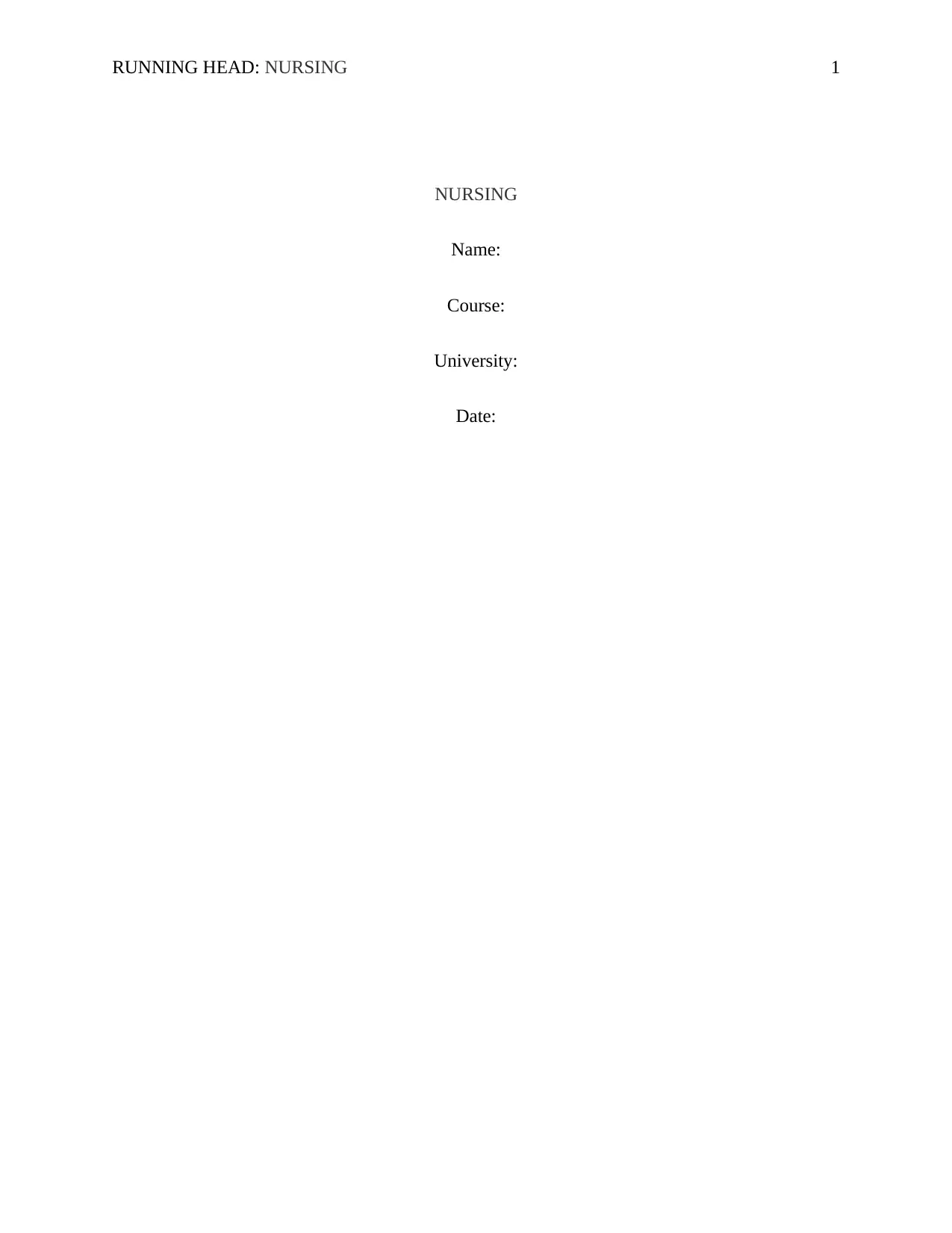
RUNNING HEAD: NURSING 1
NURSING
Name:
Course:
University:
Date:
NURSING
Name:
Course:
University:
Date:
Paraphrase This Document
Need a fresh take? Get an instant paraphrase of this document with our AI Paraphraser
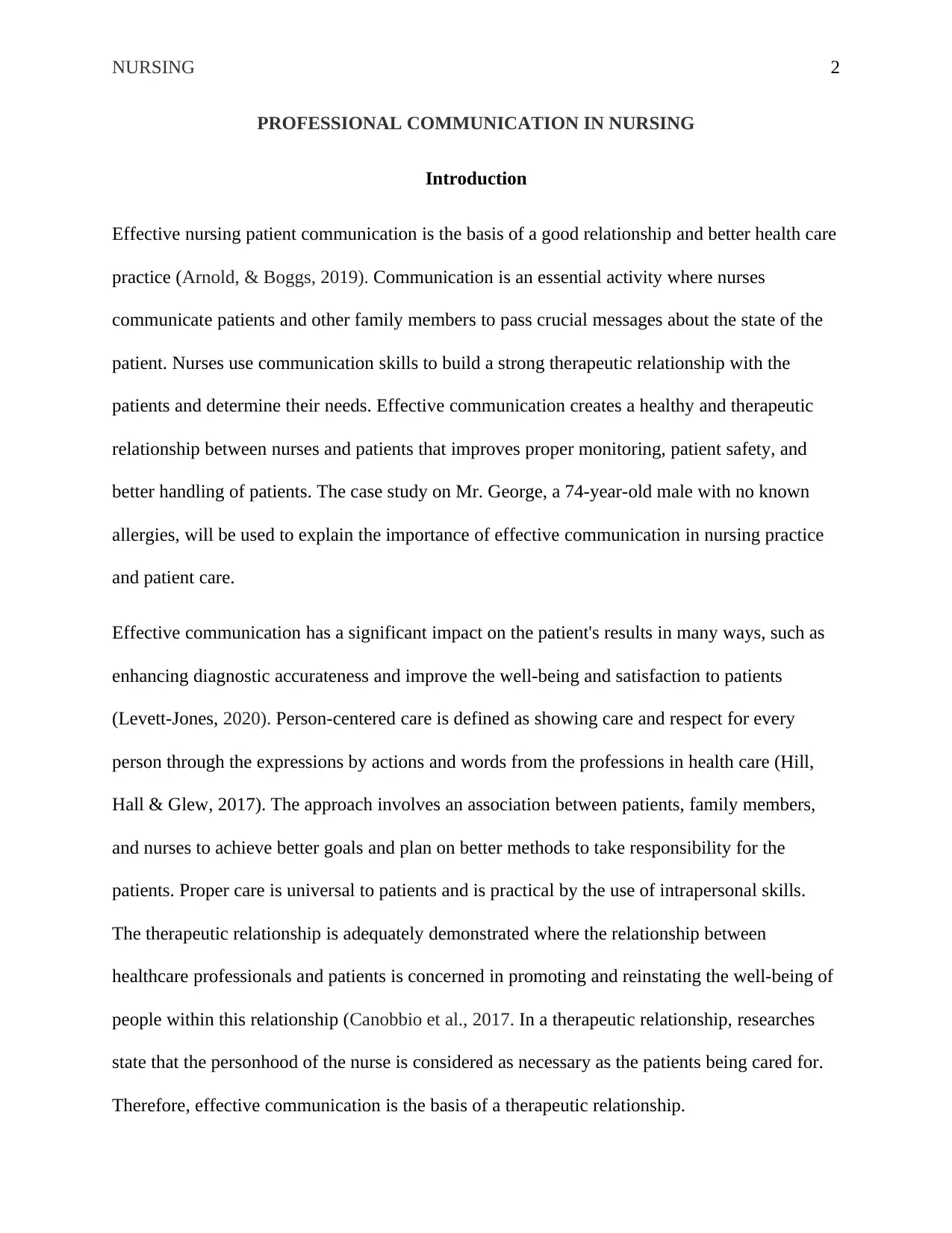
NURSING 2
PROFESSIONAL COMMUNICATION IN NURSING
Introduction
Effective nursing patient communication is the basis of a good relationship and better health care
practice (Arnold, & Boggs, 2019). Communication is an essential activity where nurses
communicate patients and other family members to pass crucial messages about the state of the
patient. Nurses use communication skills to build a strong therapeutic relationship with the
patients and determine their needs. Effective communication creates a healthy and therapeutic
relationship between nurses and patients that improves proper monitoring, patient safety, and
better handling of patients. The case study on Mr. George, a 74-year-old male with no known
allergies, will be used to explain the importance of effective communication in nursing practice
and patient care.
Effective communication has a significant impact on the patient's results in many ways, such as
enhancing diagnostic accurateness and improve the well-being and satisfaction to patients
(Levett-Jones, 2020). Person-centered care is defined as showing care and respect for every
person through the expressions by actions and words from the professions in health care (Hill,
Hall & Glew, 2017). The approach involves an association between patients, family members,
and nurses to achieve better goals and plan on better methods to take responsibility for the
patients. Proper care is universal to patients and is practical by the use of intrapersonal skills.
The therapeutic relationship is adequately demonstrated where the relationship between
healthcare professionals and patients is concerned in promoting and reinstating the well-being of
people within this relationship (Canobbio et al., 2017. In a therapeutic relationship, researches
state that the personhood of the nurse is considered as necessary as the patients being cared for.
Therefore, effective communication is the basis of a therapeutic relationship.
PROFESSIONAL COMMUNICATION IN NURSING
Introduction
Effective nursing patient communication is the basis of a good relationship and better health care
practice (Arnold, & Boggs, 2019). Communication is an essential activity where nurses
communicate patients and other family members to pass crucial messages about the state of the
patient. Nurses use communication skills to build a strong therapeutic relationship with the
patients and determine their needs. Effective communication creates a healthy and therapeutic
relationship between nurses and patients that improves proper monitoring, patient safety, and
better handling of patients. The case study on Mr. George, a 74-year-old male with no known
allergies, will be used to explain the importance of effective communication in nursing practice
and patient care.
Effective communication has a significant impact on the patient's results in many ways, such as
enhancing diagnostic accurateness and improve the well-being and satisfaction to patients
(Levett-Jones, 2020). Person-centered care is defined as showing care and respect for every
person through the expressions by actions and words from the professions in health care (Hill,
Hall & Glew, 2017). The approach involves an association between patients, family members,
and nurses to achieve better goals and plan on better methods to take responsibility for the
patients. Proper care is universal to patients and is practical by the use of intrapersonal skills.
The therapeutic relationship is adequately demonstrated where the relationship between
healthcare professionals and patients is concerned in promoting and reinstating the well-being of
people within this relationship (Canobbio et al., 2017. In a therapeutic relationship, researches
state that the personhood of the nurse is considered as necessary as the patients being cared for.
Therefore, effective communication is the basis of a therapeutic relationship.
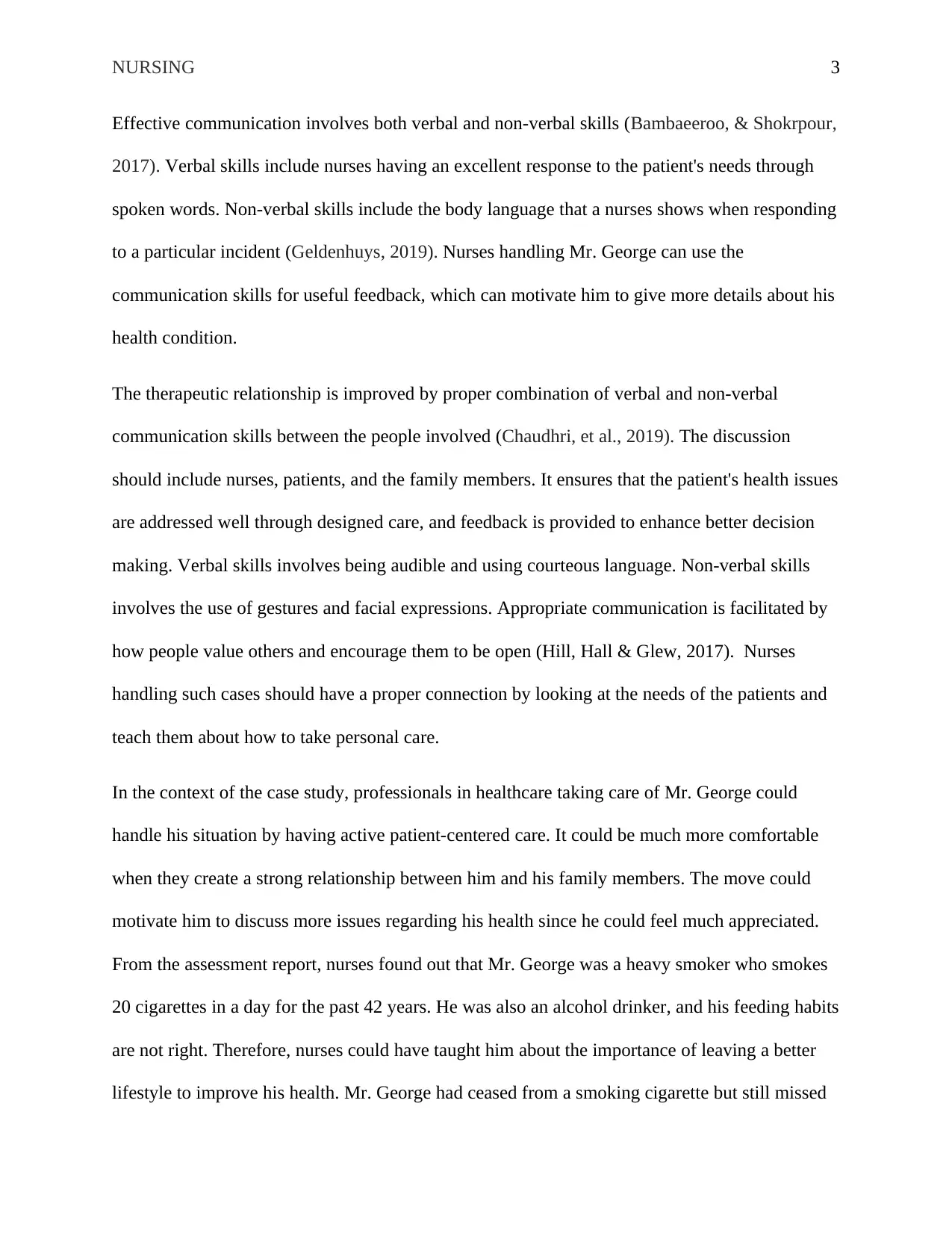
NURSING 3
Effective communication involves both verbal and non-verbal skills (Bambaeeroo, & Shokrpour,
2017). Verbal skills include nurses having an excellent response to the patient's needs through
spoken words. Non-verbal skills include the body language that a nurses shows when responding
to a particular incident (Geldenhuys, 2019). Nurses handling Mr. George can use the
communication skills for useful feedback, which can motivate him to give more details about his
health condition.
The therapeutic relationship is improved by proper combination of verbal and non-verbal
communication skills between the people involved (Chaudhri, et al., 2019). The discussion
should include nurses, patients, and the family members. It ensures that the patient's health issues
are addressed well through designed care, and feedback is provided to enhance better decision
making. Verbal skills involves being audible and using courteous language. Non-verbal skills
involves the use of gestures and facial expressions. Appropriate communication is facilitated by
how people value others and encourage them to be open (Hill, Hall & Glew, 2017). Nurses
handling such cases should have a proper connection by looking at the needs of the patients and
teach them about how to take personal care.
In the context of the case study, professionals in healthcare taking care of Mr. George could
handle his situation by having active patient-centered care. It could be much more comfortable
when they create a strong relationship between him and his family members. The move could
motivate him to discuss more issues regarding his health since he could feel much appreciated.
From the assessment report, nurses found out that Mr. George was a heavy smoker who smokes
20 cigarettes in a day for the past 42 years. He was also an alcohol drinker, and his feeding habits
are not right. Therefore, nurses could have taught him about the importance of leaving a better
lifestyle to improve his health. Mr. George had ceased from a smoking cigarette but still missed
Effective communication involves both verbal and non-verbal skills (Bambaeeroo, & Shokrpour,
2017). Verbal skills include nurses having an excellent response to the patient's needs through
spoken words. Non-verbal skills include the body language that a nurses shows when responding
to a particular incident (Geldenhuys, 2019). Nurses handling Mr. George can use the
communication skills for useful feedback, which can motivate him to give more details about his
health condition.
The therapeutic relationship is improved by proper combination of verbal and non-verbal
communication skills between the people involved (Chaudhri, et al., 2019). The discussion
should include nurses, patients, and the family members. It ensures that the patient's health issues
are addressed well through designed care, and feedback is provided to enhance better decision
making. Verbal skills involves being audible and using courteous language. Non-verbal skills
involves the use of gestures and facial expressions. Appropriate communication is facilitated by
how people value others and encourage them to be open (Hill, Hall & Glew, 2017). Nurses
handling such cases should have a proper connection by looking at the needs of the patients and
teach them about how to take personal care.
In the context of the case study, professionals in healthcare taking care of Mr. George could
handle his situation by having active patient-centered care. It could be much more comfortable
when they create a strong relationship between him and his family members. The move could
motivate him to discuss more issues regarding his health since he could feel much appreciated.
From the assessment report, nurses found out that Mr. George was a heavy smoker who smokes
20 cigarettes in a day for the past 42 years. He was also an alcohol drinker, and his feeding habits
are not right. Therefore, nurses could have taught him about the importance of leaving a better
lifestyle to improve his health. Mr. George had ceased from a smoking cigarette but still missed
⊘ This is a preview!⊘
Do you want full access?
Subscribe today to unlock all pages.

Trusted by 1+ million students worldwide
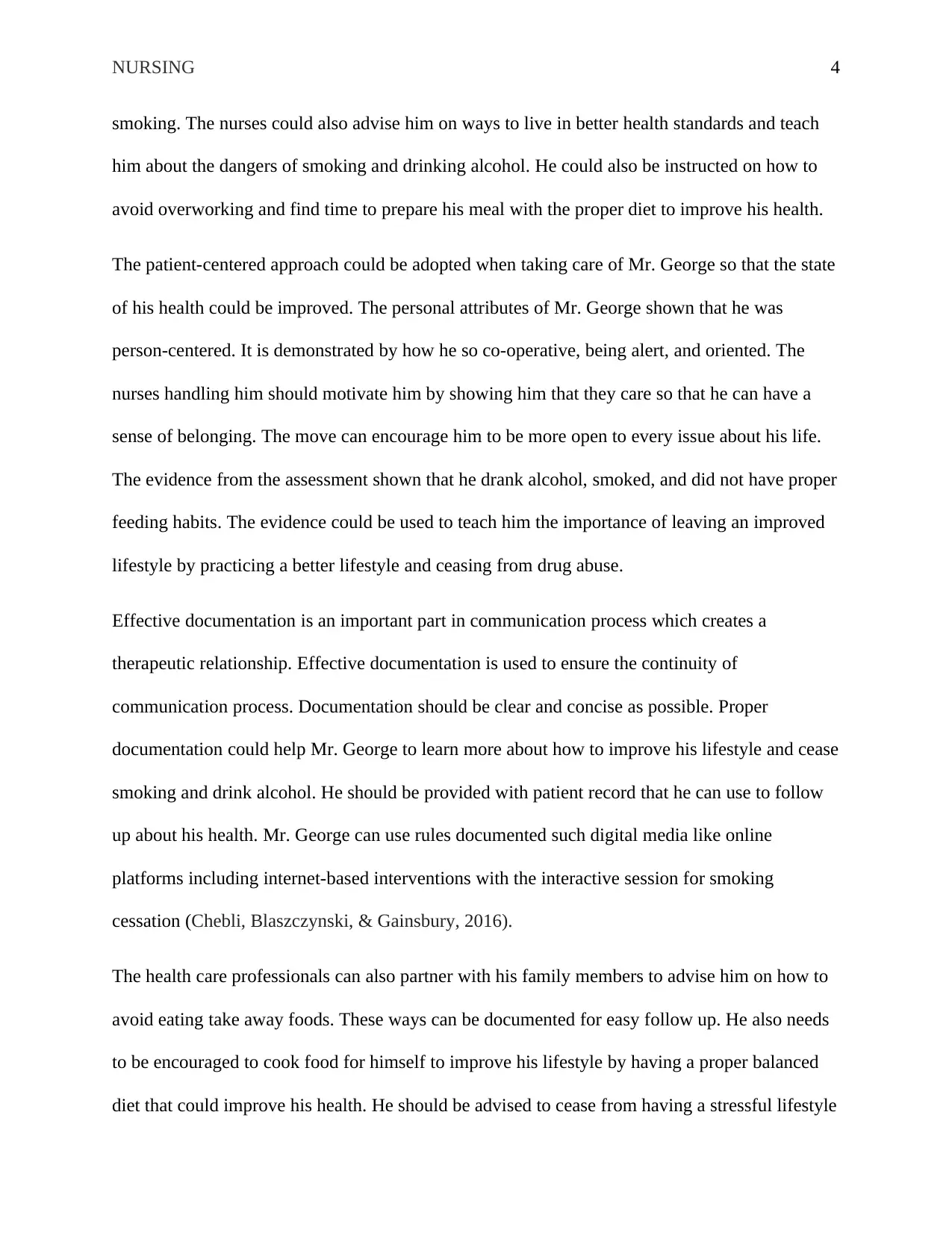
NURSING 4
smoking. The nurses could also advise him on ways to live in better health standards and teach
him about the dangers of smoking and drinking alcohol. He could also be instructed on how to
avoid overworking and find time to prepare his meal with the proper diet to improve his health.
The patient-centered approach could be adopted when taking care of Mr. George so that the state
of his health could be improved. The personal attributes of Mr. George shown that he was
person-centered. It is demonstrated by how he so co-operative, being alert, and oriented. The
nurses handling him should motivate him by showing him that they care so that he can have a
sense of belonging. The move can encourage him to be more open to every issue about his life.
The evidence from the assessment shown that he drank alcohol, smoked, and did not have proper
feeding habits. The evidence could be used to teach him the importance of leaving an improved
lifestyle by practicing a better lifestyle and ceasing from drug abuse.
Effective documentation is an important part in communication process which creates a
therapeutic relationship. Effective documentation is used to ensure the continuity of
communication process. Documentation should be clear and concise as possible. Proper
documentation could help Mr. George to learn more about how to improve his lifestyle and cease
smoking and drink alcohol. He should be provided with patient record that he can use to follow
up about his health. Mr. George can use rules documented such digital media like online
platforms including internet-based interventions with the interactive session for smoking
cessation (Chebli, Blaszczynski, & Gainsbury, 2016).
The health care professionals can also partner with his family members to advise him on how to
avoid eating take away foods. These ways can be documented for easy follow up. He also needs
to be encouraged to cook food for himself to improve his lifestyle by having a proper balanced
diet that could improve his health. He should be advised to cease from having a stressful lifestyle
smoking. The nurses could also advise him on ways to live in better health standards and teach
him about the dangers of smoking and drinking alcohol. He could also be instructed on how to
avoid overworking and find time to prepare his meal with the proper diet to improve his health.
The patient-centered approach could be adopted when taking care of Mr. George so that the state
of his health could be improved. The personal attributes of Mr. George shown that he was
person-centered. It is demonstrated by how he so co-operative, being alert, and oriented. The
nurses handling him should motivate him by showing him that they care so that he can have a
sense of belonging. The move can encourage him to be more open to every issue about his life.
The evidence from the assessment shown that he drank alcohol, smoked, and did not have proper
feeding habits. The evidence could be used to teach him the importance of leaving an improved
lifestyle by practicing a better lifestyle and ceasing from drug abuse.
Effective documentation is an important part in communication process which creates a
therapeutic relationship. Effective documentation is used to ensure the continuity of
communication process. Documentation should be clear and concise as possible. Proper
documentation could help Mr. George to learn more about how to improve his lifestyle and cease
smoking and drink alcohol. He should be provided with patient record that he can use to follow
up about his health. Mr. George can use rules documented such digital media like online
platforms including internet-based interventions with the interactive session for smoking
cessation (Chebli, Blaszczynski, & Gainsbury, 2016).
The health care professionals can also partner with his family members to advise him on how to
avoid eating take away foods. These ways can be documented for easy follow up. He also needs
to be encouraged to cook food for himself to improve his lifestyle by having a proper balanced
diet that could improve his health. He should be advised to cease from having a stressful lifestyle
Paraphrase This Document
Need a fresh take? Get an instant paraphrase of this document with our AI Paraphraser
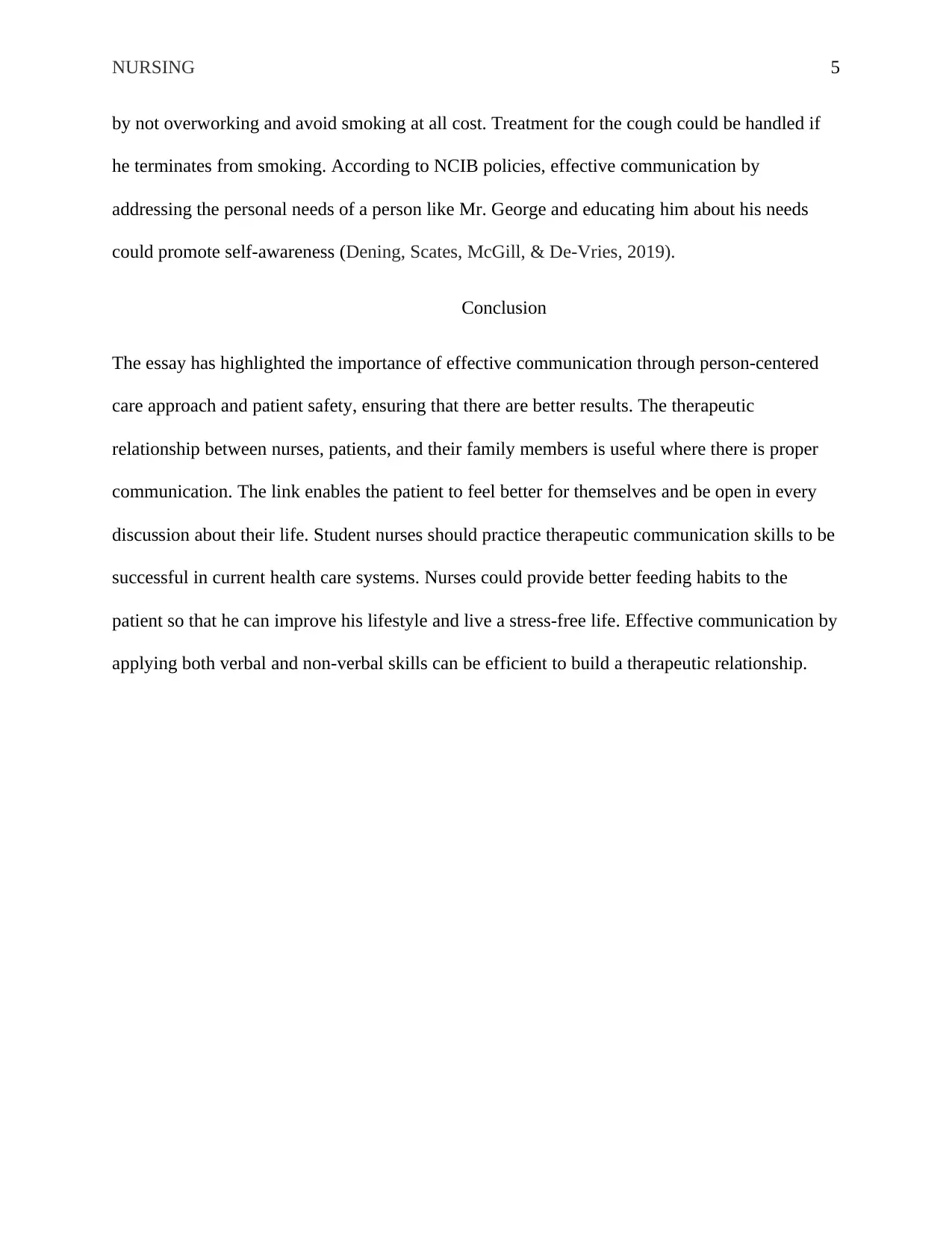
NURSING 5
by not overworking and avoid smoking at all cost. Treatment for the cough could be handled if
he terminates from smoking. According to NCIB policies, effective communication by
addressing the personal needs of a person like Mr. George and educating him about his needs
could promote self-awareness (Dening, Scates, McGill, & De-Vries, 2019).
Conclusion
The essay has highlighted the importance of effective communication through person-centered
care approach and patient safety, ensuring that there are better results. The therapeutic
relationship between nurses, patients, and their family members is useful where there is proper
communication. The link enables the patient to feel better for themselves and be open in every
discussion about their life. Student nurses should practice therapeutic communication skills to be
successful in current health care systems. Nurses could provide better feeding habits to the
patient so that he can improve his lifestyle and live a stress-free life. Effective communication by
applying both verbal and non-verbal skills can be efficient to build a therapeutic relationship.
by not overworking and avoid smoking at all cost. Treatment for the cough could be handled if
he terminates from smoking. According to NCIB policies, effective communication by
addressing the personal needs of a person like Mr. George and educating him about his needs
could promote self-awareness (Dening, Scates, McGill, & De-Vries, 2019).
Conclusion
The essay has highlighted the importance of effective communication through person-centered
care approach and patient safety, ensuring that there are better results. The therapeutic
relationship between nurses, patients, and their family members is useful where there is proper
communication. The link enables the patient to feel better for themselves and be open in every
discussion about their life. Student nurses should practice therapeutic communication skills to be
successful in current health care systems. Nurses could provide better feeding habits to the
patient so that he can improve his lifestyle and live a stress-free life. Effective communication by
applying both verbal and non-verbal skills can be efficient to build a therapeutic relationship.
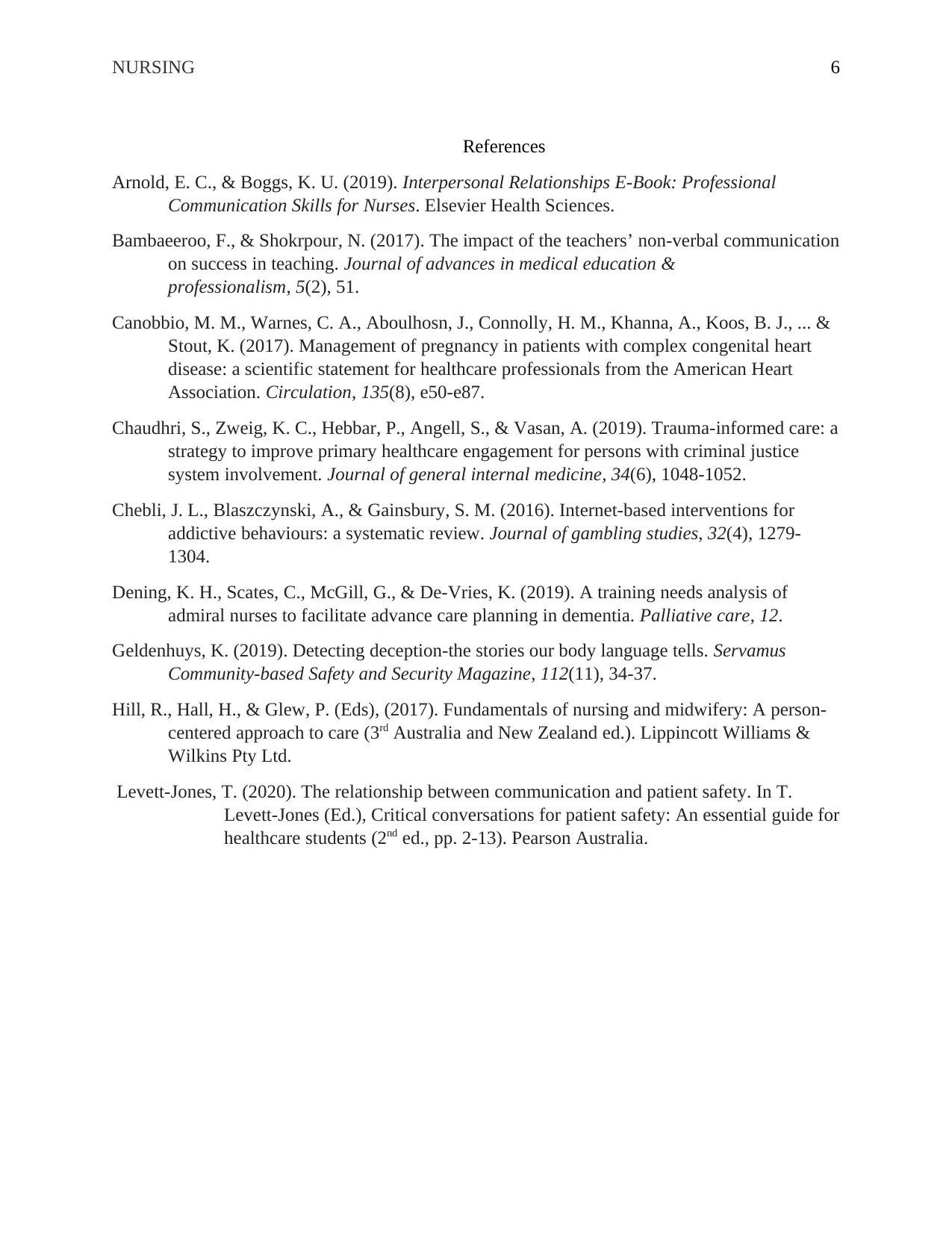
NURSING 6
References
Arnold, E. C., & Boggs, K. U. (2019). Interpersonal Relationships E-Book: Professional
Communication Skills for Nurses. Elsevier Health Sciences.
Bambaeeroo, F., & Shokrpour, N. (2017). The impact of the teachers’ non-verbal communication
on success in teaching. Journal of advances in medical education &
professionalism, 5(2), 51.
Canobbio, M. M., Warnes, C. A., Aboulhosn, J., Connolly, H. M., Khanna, A., Koos, B. J., ... &
Stout, K. (2017). Management of pregnancy in patients with complex congenital heart
disease: a scientific statement for healthcare professionals from the American Heart
Association. Circulation, 135(8), e50-e87.
Chaudhri, S., Zweig, K. C., Hebbar, P., Angell, S., & Vasan, A. (2019). Trauma-informed care: a
strategy to improve primary healthcare engagement for persons with criminal justice
system involvement. Journal of general internal medicine, 34(6), 1048-1052.
Chebli, J. L., Blaszczynski, A., & Gainsbury, S. M. (2016). Internet-based interventions for
addictive behaviours: a systematic review. Journal of gambling studies, 32(4), 1279-
1304.
Dening, K. H., Scates, C., McGill, G., & De-Vries, K. (2019). A training needs analysis of
admiral nurses to facilitate advance care planning in dementia. Palliative care, 12.
Geldenhuys, K. (2019). Detecting deception-the stories our body language tells. Servamus
Community-based Safety and Security Magazine, 112(11), 34-37.
Hill, R., Hall, H., & Glew, P. (Eds), (2017). Fundamentals of nursing and midwifery: A person-
centered approach to care (3rd Australia and New Zealand ed.). Lippincott Williams &
Wilkins Pty Ltd.
Levett-Jones, T. (2020). The relationship between communication and patient safety. In T.
Levett-Jones (Ed.), Critical conversations for patient safety: An essential guide for
healthcare students (2nd ed., pp. 2-13). Pearson Australia.
References
Arnold, E. C., & Boggs, K. U. (2019). Interpersonal Relationships E-Book: Professional
Communication Skills for Nurses. Elsevier Health Sciences.
Bambaeeroo, F., & Shokrpour, N. (2017). The impact of the teachers’ non-verbal communication
on success in teaching. Journal of advances in medical education &
professionalism, 5(2), 51.
Canobbio, M. M., Warnes, C. A., Aboulhosn, J., Connolly, H. M., Khanna, A., Koos, B. J., ... &
Stout, K. (2017). Management of pregnancy in patients with complex congenital heart
disease: a scientific statement for healthcare professionals from the American Heart
Association. Circulation, 135(8), e50-e87.
Chaudhri, S., Zweig, K. C., Hebbar, P., Angell, S., & Vasan, A. (2019). Trauma-informed care: a
strategy to improve primary healthcare engagement for persons with criminal justice
system involvement. Journal of general internal medicine, 34(6), 1048-1052.
Chebli, J. L., Blaszczynski, A., & Gainsbury, S. M. (2016). Internet-based interventions for
addictive behaviours: a systematic review. Journal of gambling studies, 32(4), 1279-
1304.
Dening, K. H., Scates, C., McGill, G., & De-Vries, K. (2019). A training needs analysis of
admiral nurses to facilitate advance care planning in dementia. Palliative care, 12.
Geldenhuys, K. (2019). Detecting deception-the stories our body language tells. Servamus
Community-based Safety and Security Magazine, 112(11), 34-37.
Hill, R., Hall, H., & Glew, P. (Eds), (2017). Fundamentals of nursing and midwifery: A person-
centered approach to care (3rd Australia and New Zealand ed.). Lippincott Williams &
Wilkins Pty Ltd.
Levett-Jones, T. (2020). The relationship between communication and patient safety. In T.
Levett-Jones (Ed.), Critical conversations for patient safety: An essential guide for
healthcare students (2nd ed., pp. 2-13). Pearson Australia.
⊘ This is a preview!⊘
Do you want full access?
Subscribe today to unlock all pages.

Trusted by 1+ million students worldwide
1 out of 6
Related Documents
Your All-in-One AI-Powered Toolkit for Academic Success.
+13062052269
info@desklib.com
Available 24*7 on WhatsApp / Email
![[object Object]](/_next/static/media/star-bottom.7253800d.svg)
Unlock your academic potential
© 2024 | Zucol Services PVT LTD | All rights reserved.





